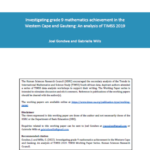Investigating grade 9 mathematics achievement in the Western Cape and Gauteng: An analysis of TIMSS 2019

In the 2019 Trends in International Mathematics and Science Study (TIMSS), two of nine South African provincial education departments sought to increase the precision of their performance estimates through the participation of a larger school sample. This enables the comparison of students’ mathematics performance in these two provinces against each other and against the combined performance of seven remaining provinces. Using these data, we identify relative system efficiencies at work in Gauteng and the Western Cape as reflected in notably higher levels of grade 9 mathematics achievement in these provinces compared to seven other provinces, after accounting for student compositional and school resourcing differences. In no-fee charging schools, a significant learning advantage in favour of Gauteng and particularly the Western Cape relative to seven other provinces is evident among equally poor students with similar school and home background characteristics. Importantly though, provincial performance gaps are much larger if socio-economic and home background differences across students are not accounted for. A learning improvement agenda, including active measures to improve the quality of teaching in schools supported through functional administrations, should happen in parallel with a programme of economic growth and poverty alleviation. Notwithstanding, the Gauteng and particularly the Western Cape advantage in no-fee schools is evidence that education systems can do better with what they have and given the poverty levels of the children they serve. Yet, international comparisons imply that even these better performing provinces could improve. This points to the continued importance of the development of state capability across all education departments in shaping the effectiveness of schooling.
